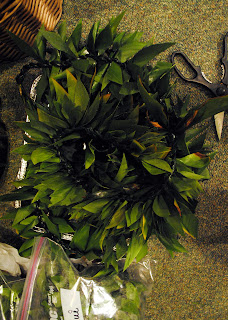Next time you visit the Honolulu Zoo, be sure to stop in the Keiki Zoo. Just to the left of the entrance, near the overstocked Koi pond that also has as few ducks milling about, is the breadfruit tree that all of the Samoan security guards lust over. This tree has the tastiest breadfruit around, and I got to have some. Twice.
I'd noticed the gigantic green orbs while raking the grass near the pond and asked about them during a casual conversation with Les, a kind zoo volunteer I've met recently. I found myself involved in a new project. Les couldn't believe that I'd never had breadfruit, deciding to take matters into his own hands immediately. The final ninety minutes of the zoo shift finds the keepers and volunteers searching for odd jobs to do to stay busy, talking, or spending time on smartphones, so we were all in for a little action. A small group of us followed Les to the massive tree, our interest instantly piqued when he came out of the shed with a huge fishing net. It didn't look like he was interested in the low hanging fruit.
A breadfruit that's ready to be eaten will have white milky droppings all over it, appearing to have been recently pooped on by one of the feral pigeons. It certainly doesn't look appealing at first glance. After Les reached and tugged at a high, oozing breadfruit, we all heard a, "Dunk!" before a big splash startled the ducks. The breadfruit had fallen into the pond. Ick. Les fished it out and handed it to me, sopping wet and sticky. All I could do was smile and say thanks.
With fifteen minutes left of our shift, I held onto the giant ball, similar in size to a coconut, trying not to look awkward. Several visitors asked me what I had, and why. There were no real easy answers. Les shared his methods for cooking the starch, but no one was sure about how to tell when it would be ripe enough to eat. When the security guard came to relieve us (they keep watch of the petting areas while everyone takes lunch), I asked him for some tips, which he was happy to share.
The nice Samoan told me to keep my new prize on the counter at home for a couple of days to let it get a little soft, like an avocado. In the meantime, I looked online to find recipes and suggestions for how to prepare it. The security guard wasn't kidding when he told me to use an empty can to shave off its skin. I found a
YouTube video that did just that. Well, since we're leasing a furnished condo, I decided to avoid ruining a knife trying to cut a can of beans in half, especially since I've broken 3 or 4 water glasses and two wine glasses in the past 5 months. It's not me; they're super cheap. And, I'm klutzy. Mostly, they're super cheap.
Notice the poop-like white milky markings. I'm not too sure what the dark spot are, but no one seemed alarmed.
I chose the easiest method: to just cut the thing open with a good ole fashioned knife, chop it up into cubes, then boil it for a few minutes. I wasn't making this for a dinner party or anything, more because Les picked it for me. I didn't expect to get Jeff to eat much and didn't want to take too much time preparing anything gourmet. The thing did fall into a nasty pond for heaven's sake. I guess
Jamaican style would've been even easier, since after a couple of cuts, the whole thing goes in the oven to bake for an hour. As previously stated, we're
leasing a condo.
I only used a quarter, not intending to ruin my dinner. After 10 minutes in boiling water, I called it ready. A tiny bit of butter, salt, and pepper, and it's done.
Absolutely tasted like a potato with a hint of sweet at the finish. Also, it's a touch stickier than potato. I convinced Jeff to take a bite. He made a face during the entire process, even while just picking up a fork to stab a chunk. He didn't mind it but has preconceived notions about texture and sets himself up. I don't expect that this will become a staple in our household.
The next week at the zoo, I told of my tasting and enjoyment of preparing the breadfruit. One of the zoo volunteers is a successful chef who gloated about his amazing breadfruit dishes. This spurred on the suggestion to hold a potluck lunch where Tony would make us a scrumptious dish using the breadfruit from the zoo. He did not let us down. I'm not sure what was in his mash besides butter, chives, salt, and pepper, but it was super good. I even had seconds.
















